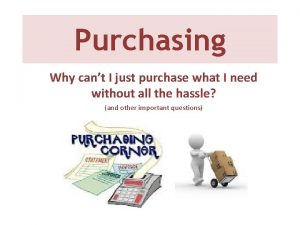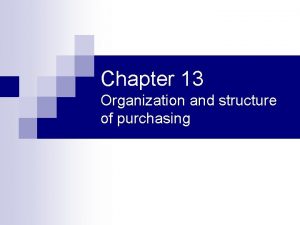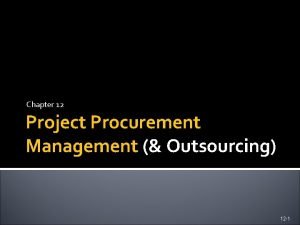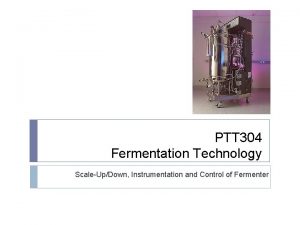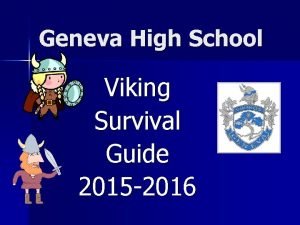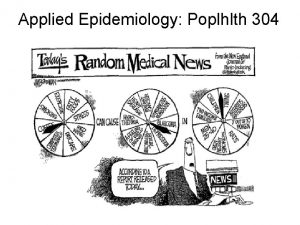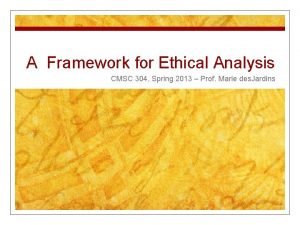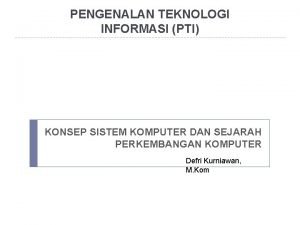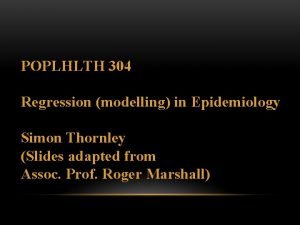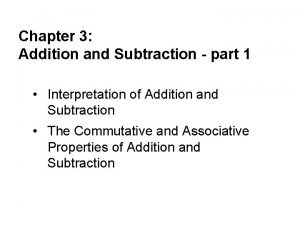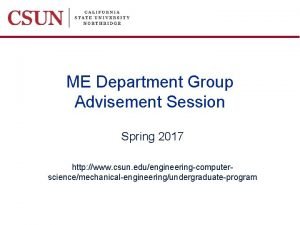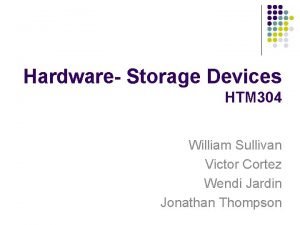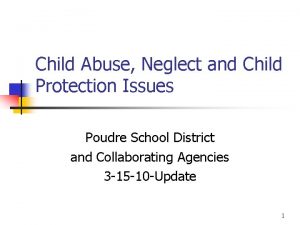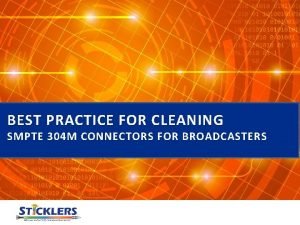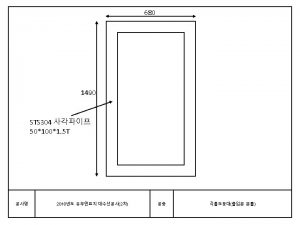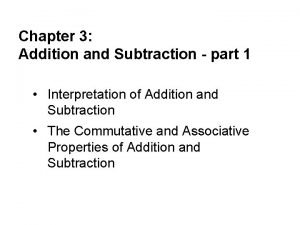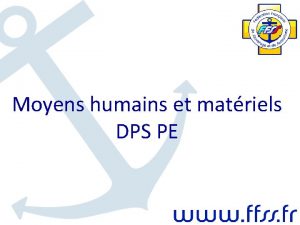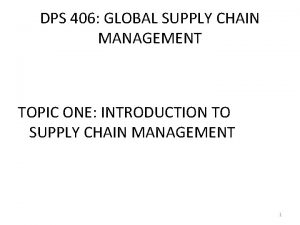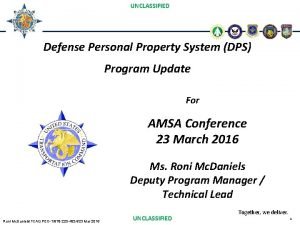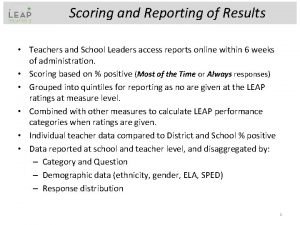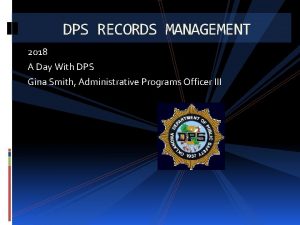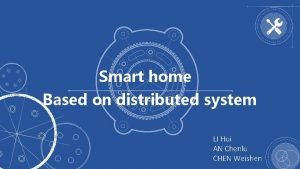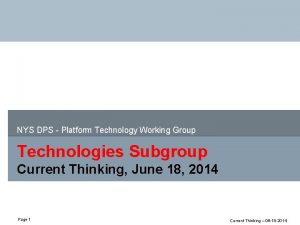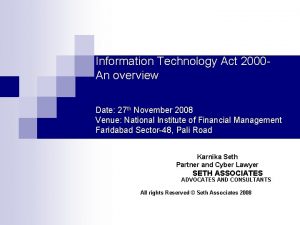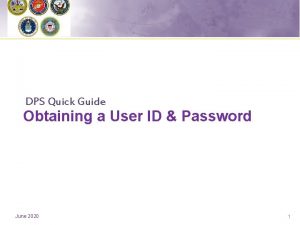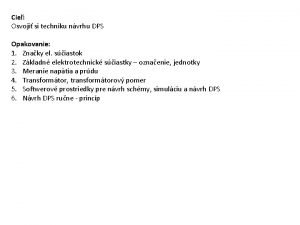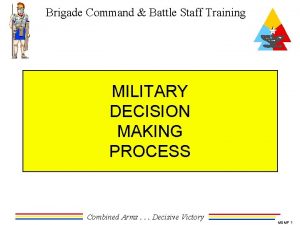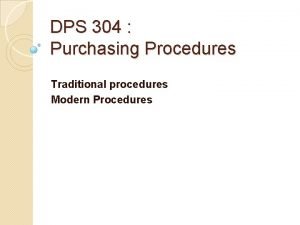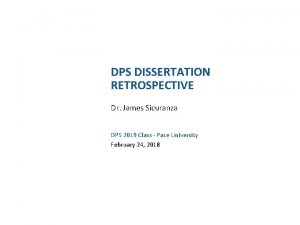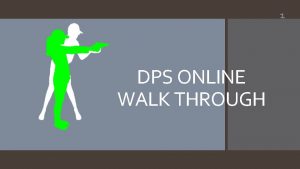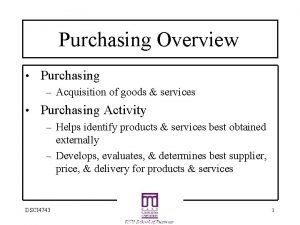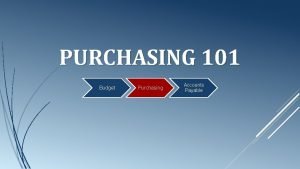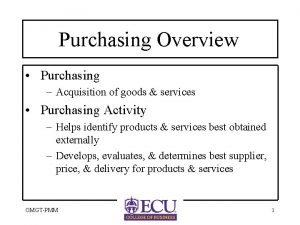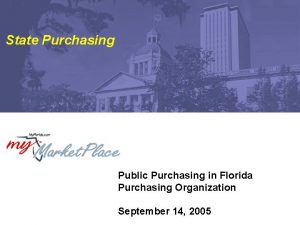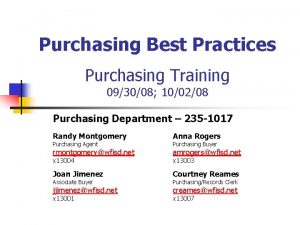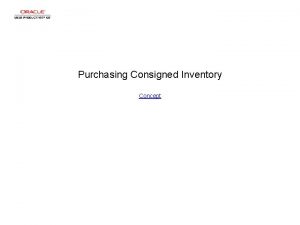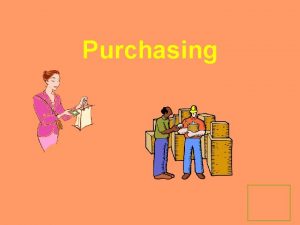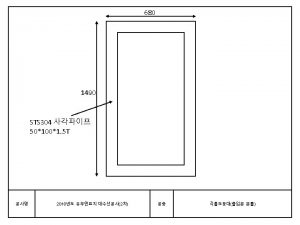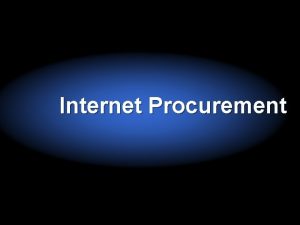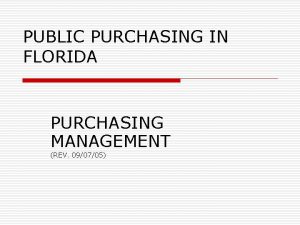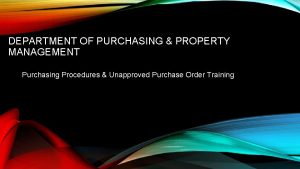DPS 304 Procurement Management Procurement as Purchasing v

































- Slides: 33

DPS 304 : Procurement Management Procurement as Purchasing v. Purchasing has long been considered one of the basic functions common to all organizations. v. It is believed that the first college textbook that focused on Purchasing was authored by Howard T. Lewis of Harvard University in 1933. v. Senior management’s interests historically have focused on marketing, research and development, finance and operations while purchasing and materials management have all frequently been subordinated to these similar functions.

Definition of Purchasing Definition One – To buy the right quality, in the right quantity from the right source delivered to the right place at the right time at the right price Criticism of Def. ; 1. What is ‘right’ is contingent on a particular organization or situation 2. Some rights are irreconcilable – implies trade offs 3. Def implies purchasing is reactive rather than proactive 4. Implies purchasing is transactional rather than relational 5. Implies purchasing is tactical rather than strategic

Definition of Purchasing as Procurement v. Procurement is a wider term than purchasing which implies the acquisition of goods or services in return for monetary or equivalent payment. v. Procurement is the process of obtaining goods or services in any way including borrowing, leasing and management of quality and supplier relationships

Definition of Purchasing A composite Definition Purchasing, the process undertaken by the organizational unit that either as a function or as part of an integrated supply chain, is responsible for procuring or assisting users to procure, in the most efficient manner, required supplies at the right time, quality, quantity and price and the management of suppliers, thereby contributing to the competitive advantage of the enterprise and the achievement of corporate strategy.

Definition of Purchasing This definition has the following significant terms: q. Processes – flow of activities in procuring goods or services q. Organizational unit – cost or profit centre charged with the responsibility of purchasing. q. Function – unit or department in which people use specialised knowledge, skills and resources to perform specialised tasks q. Integrated supply chain – absorption of formerly independent functional units such as purchasing, materials management, production and distribution into a continuous flow of interaction.

Perspectives of Purchasing v. As a function – people use specialized skills & resources to perform specialized tasks. v. As a process – sequential chain of events leading to the acquisition of supplies v. Receive requisition » solicit quotations » negotiate with suppliers » place order » receive supplies » make payment v. As a link in the supply chain v. As a relationship – internal & external relationships, long & short-term

Perspectives of Purchasing v. Externally, relationships with suppliers as shown later, may represent a continuum from arm’s length to supplier alliances. Many organizations now rely on suppliers to design, develop and manufacture items that they would previously produce as Ford et Al. observe: The main issue facing managers is no longer about ‘buying the right products at the right time at the right price’ but of handling & developing relationships with key suppliers over long periods

Perspectives of Purchasing v. As problem-solving –Customers are not looking for a product from a manufacturer, instead they seek a solution to a problem from a supplier. Business purchases are problem driven. v. As a discipline – a branch of Knowledge, an area of study. The academic content of purchasing lacks the clearly defined focus associated with other fields of study such as mathematics, economics & law & draws heavily on other subjects to build its knowledge base eg accounting, economics, ethics, IT, OR etc

Perspectives of Purchasing v. Purchasing a profession v. Generally a an area may be regarded as a profession if the practitioners abide by the following v. Body of theoretical knowledge v. Professional body to govern minimum qualifications for entrance, enforce rules and norms of conduct v. Code of professional ethics v. Prolonged training and education

Perspectives of Purchasing q. Purchasing a profession When you choose to be a professional in this area, you will be expected to have the following qualities: Responsibility to the Profession Assist in maintaining the integrity of the profession and participate in its activities. Your conduct toward colleagues and clients should be characterized by courtesy and good faith. Authority Act with proper authority from your client or institution regardless of good faith and be responsible for any harm caused to clients or institution as a result of acting without authority

Perspectives of Purchasing q. Purchasing a profession Integrity You must perform with integrity all responsibilities owed to clients, the institution, other members of the profession and the public. The principle of integrity is a key element of this profession. If personal integrity is lacking, your professional’s usefulness to the client and institution, and reputation within the profession will be destroyed regardless of how competent you may be. 4. Competence and Quality of Service Competence on the part of the professional means the provision of an adequate standard of service, skill and knowledge in planning and management activities on behalf of a client. Competence involves an adequate knowledge of practice and procedures.

Perspectives of Purchasing q. Purchasing a profession The list that follows is illustrative of examples of meeting client’s quality of service: §Keeping the clients, service providers, and staff reasonably informed. §Answering reasonable requests from clients. §Adhering to planning schedules and deadlines. §Striving to maintain adequate office staff and facilities. §Practicing effective office management skills. §Providing information to the client and institution and disclosing neglect or mistakes. §Providing prompt and complete reports and §Maintaining judgment in personal and professional conduct, in adherence with institutional policies.

Perspectives of Purchasing q. Purchasing a profession Confidential Information You will be duty bound to hold in confidence all information concerning the business and affairs of the client acquired in the course of the professional relationship, and should not divulge such information unless authorized by the client. There a difference between confidential information and private information. Briefly think through the differences. Conflict of Interest You will have the right to engage in activities which are of a private nature outside your formal employment or clients engagements. However, you must not use your position in any way to induce another person to provide any benefit to themselves, or persons with whom they have family, business, personal, or financial ties.

Perspectives of Purchasing q. Purchasing a profession Discrimination Act in accordance with the laws of your country and your institutional policies in relation to discrimination on the basis of race, national or ethnic origin, colour, religion, sex, marital or family status, disability or age. Is there any form of discrimination which formally allowed? Outside Interests If you will end up concurrently engaging in another profession, business or occupation you must not allow such outside interest to jeopardize your integrity, independence or competence. In your opinion the term "outside interest" covers what?

The Evolution of Purchasing q. Purchasing represents a stage in the evolution of civilized human relationships as it enables a desired object to be obtained by trading rather than conquest, plunder or confiscation. q. A clay tablet excavated at El-Rash Shamra, northern Syria, dated 2800 B. C carries an inscription that, roughly translated reads: ‘HST to deliver 50 jars of fragrant smooth oil 15 days (a starting date) and during the reign of AS. In return he will be paid 600 small weight in grain. This order will continue indefinitely until the purchaser or his son removes his consent.

The Evolution of Purchasing q. Before 1900 there were few instances of purchasing departments separate from other operating departments. Purchasing departments as did exist were found mainly in the railroad field. It is worth noting at this point that rail and road transport were among first fields that benefited greatly from industrial revolution and hence needed to deal with multiple suppliers and also stock several components for maintenance. q. Purchasing came of age during the early part of World War I, under the impact of expanded production brought about by the war. Howard T. Lewis of Harvard University wrote “Industrial Purchasing” in 1938. The 1950’s recession diverted the attention to cost-cutting efforts on purchased supplies.

The Evolution of Purchasing q. According to Reck & Long q. Stage 1 - Passive Definition q. Purchasing function has no strategic direction and primarily reacts to the requests of other functions Characteristics q. High proportion of time on quick-fix routine operations q. Functional and individual communications due to purchasing low visibility q. Supplier selection based on price and availability

The Evolution of Purchasing q. Stage 2 q. Independent Definition q. Purchasing function adopts the latest purchasing techniques and processes, but its strategic direction is independent of the firms competitive strategy Characteristics q. Performance based primarily on cost reduction and efficiency disciplines q. Coordination links are established between purchasing and technical disciplines q. Top management recognises the importance of professional development q. Top management recognises the opportunities in purchasing for contribution to profitability

The Evolution of Purchasing Stage 3 - Supportive Def The purchasing function supports the firms competitive strategy by adopting purchasing techniques and products which strengthen the firms competitive position Characteristics q. Purchasers are included in sales proposal teams q. Suppliers are considered a resource, with emphasis on experience, motivation and attitude q. Markets, products and suppliers are continuously monitored analysed

The Evolution of Purchasing Stage 4 – Integrative Def Purchasings strategy is fully integrated into the firms competitive strategy and constitutes part of an integrated effort among functional peers to formulate and implement strategic plan Characteristics q. Cross-functional training of purchasing professionals and executives is made available q. Permanent lines of communication are established with other functional areas q. Professional development focuses on strategic elements of the competitive strategy q. Purchasing performance is measured in terms of contribution to the firms success

The Evolution of Purchasing Jones 5 stage Model q. Stage 1 – Infant q. Stage 2 – Awakening q. Stage 3 – Developing q. Stage 4 – Mature q. Stage 5 - Advanced

Purchasing & Change Three drivers have influenced & are influencing changes in purchasing philosophies, processes & procedures; q. Globalization – global sourcing q. Information technology q. Changing production & management philosophies

Purchasing & Change Globalization q. The increasing interdependence across national & geographical boundaries of people, trade & commerce driven in large part by information technology & technology generally. q. Eg. Singer sewing machine company, “it buys sewing machine shells from a subcontractor in the united states, the motors from Brazil, the drive shafts from Italy & assembles the finished machine in Taiwan.

Purchasing & Change Information Technology q. By sharing information & processing electronic transactions over the internet, suppliers are being converted into e-suppliers Changing production & management philosophies q. Global competition has intensified the search for strategies that will yield competitive advantage eg. Reduced inventories, just-in-time, Total quality mgt, supplier collaboration, time based competition, lean & agile production & supply management

Purchasing & Change Changing Aspects of Purchasing & Supply Management Aspect Traditional Changing Structure Procedures Purchase Considerations Vertical, hierarchical Horizontal, flatter, selffunctionally oriented managed & cross. Purchasing regarded as functional a separate function realtionaships Purchasing regarded as part of an integrated supply chain Paper-based, slow, high Based on IT cost All procurement applications, Rapid, low routed thro purchasing cost Increased emphasis on centre-led, user procurement Price only Total Cost of Buy What we can't Acquisition & use make subcontract or outsource non-core business

Purchasing & Change Changing Aspects of Purchasing & Supply Management Aspect Traditional Changing Sourcing Multisourcing. Local or national Little use of purchasing consortia Reducing supplier base Global Increasing use of purchasing consortia Short-term Adversarial & Confrontational Win-lose negotiations Retention of information Quality & Specification Purchaser specifications of design & quality Inspection of goods on Long-term Partnerships & collaborative Win-win negotiations Sharing of information Supplier specifications of design & quality Supplier certification Supplier relationships

Purchasing & Change Changing Aspects of Purchasing & Supply Management Aspect Traditional Changing Inventory & Lead times High to provide security Low due to JIT requirements to reduce ‘waste’. Purchasing performance Assesses mainly on price differences & savings Assessed mainly on its value-added activities as part of supply chain

Purchasing & Change Purchasing in Future Research indicates that within the decade which commenced in 2000, future trends relating to purchasing & supply management will include; q. Increase in the strategic importance of PSM – supplier evaluation, selection & mgt q. Automation of tactical activities q. Most non-tactical items will be bought under master contracts q. The internet/www will be the main vehicle for electronic purchasing q. Leading organizations will establish strategic competency centers with highly trained crossfunctional personnel

Purchasing & Change Purchasing in Future q. Strategic alliances with suppliers will increase q. Organizations in the supply chain will increasingly share resources q. Global supplier development will be critical for global penetration q. Increasing emphasis on win-win negotiation q. Dominant companies in the supply chain will influence the sourcing decision of first, second & third-tier suppliers q. Environment factors will become increasingly important to purchase considerations q. Personel employed in purchasing will require a higher level of training, including that in leadership & influence skills.

Purchasing & Change World Class Purchasing Schonberger defined world class manufacturing as analogous to the olympic motto ‘citius, altius, fortius’ (translated as faster, higher, stronger). World class manufacturing equivalent is continual & rapid improvement

Purchasing & Change World Class Purchasing Twelve characteristics of world class supplier management were identified by the USA center for Advanced Purchasing Studies; q. Commitment to total quality management q. Commitment to just-in-time q. Commitment to total cycle time reduction q. Long-range strategic plans that are multidimensional & fully integrated with overall corporate plan q. Supplier relationships, including networks, partnerships and alliances q. Performance measurements including regular benchmarking with & across industries. q. Strategic Cost Management – a total life acquisition approach to evaluating bids & use of IT

Purchasing & Change World Class Purchasing q. Training & Professional development q. Service excellence – purchasing is proactive, anticipates customers needs & demonstrates flexibility. q. Corporate social responsibility – regarding ethical, environment and safety issues & support of local suppliers q. Learning – world class purchasing recognizes that learning & education are critical factors in continuous improvement q. Management & leadership – purchasing executives earn & enjoy top management support & recognize the importance of transformational change

Exercise 1 Read on different ways of organizing the procurement function eg; centralization, Divisionalization etc
 Emergency purchase
Emergency purchase Purchasing organizational structure
Purchasing organizational structure Procurement vs purchasing
Procurement vs purchasing Ptt 304
Ptt 304 Geneva304hac
Geneva304hac Poplhlth 304
Poplhlth 304 Cmsc 304 umbc
Cmsc 304 umbc Ncr serie 304
Ncr serie 304 Iis 304
Iis 304 Poplhlth 304
Poplhlth 304 Parts of subtraction problem
Parts of subtraction problem Csun previously disqualified questionnaire
Csun previously disqualified questionnaire 3 storage devices
3 storage devices Larimer county child protective services
Larimer county child protective services Premier poc03m
Premier poc03m Sts304 pipe
Sts304 pipe Allie solves the subtraction problem 304-9 as follows
Allie solves the subtraction problem 304-9 as follows Dps solvang
Dps solvang Matriels
Matriels Dps supply chain
Dps supply chain Defense personal property system dps
Defense personal property system dps Student perception survey dps
Student perception survey dps Ea deployment diagram
Ea deployment diagram Bonham dps
Bonham dps Dps infonet
Dps infonet Ts dps
Ts dps Webgrants missouri
Webgrants missouri Smartfind express dps
Smartfind express dps Dps platform
Dps platform Webgrants mo dps
Webgrants mo dps Indian it act 2000
Indian it act 2000 Dps password
Dps password Dps menu
Dps menu Commander intent example
Commander intent example
